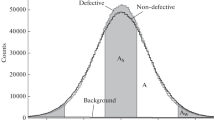Conclusions
A material with a well-developed surface is characterized by a narrowing of its AAPD curve and by the appearance of a narrow component in the small-angle region. The positron annihilation parameters of nickel powder compacts are greater than those of cast and worked nickel and grow with increasing degree of porosity, which is evidence for preferential positron localization on the pore surfaces. Using experimental data and a model of positron trapping by defects, estimates were made of the effective pore size¯Rv and pore concentration Cv as functions of the degree of porosity.
Similar content being viewed by others
Literature cited
R. Paulin, R. Ripon, and W. Brandt, “Positron diffusion in metals,” Phys. Rev. Lett.,31, No. 19, 1214–1218 (1973).
W. Brandt, “Positron dynamics in solids,” Appl. Phys.,5, No. 1, 1–23 (1974).
M. Hasegawa and Z. Suzuki, Radiat. Eff.,21, No. 3, 201 (1974).
M. I. Dekhtyar, “On the model of positron trapping by defects in metals,” Phys. Status Solidi (a),31, 669–705 (1975).
K. Pettersen, N. Thrane, and R. M. J. Cotterill, “A positron annihilation study of the annealing and void formation in neutron-irradiated molybdenum,” Phil. Mag.,29, No. 1, 9–23 (1974).
M. Eldrup, O. E. Mogensen, and J. H. Evans, “A positron annihilation study of the annealing of electron irradiated molybdenum,” J. Phys. F. Met. Phys.,6, No. 4, 499–521 (1976).
P. Jena, A. K. Cupta, and K. S. Singwi, “Positron annihilation in small metal voids,” Solid State Commun.,21, No. 3, 293–296 (1977).
I. Ya. Dekhtyar, M. R. Minev, S. G. Sakharova, and R. G. Fedchenko, Ukr. Fiz. Zh.,21, No. 11, 1789–1793 (1976).
I. Ya. Dekhtyar, A. K. Karshibaev, and Ch. Abraev, “Positron annihilation in pressed copper powders,” Ukr. Fiz. Zh.,22, No. 5, 726–730 (1977).
I. Ya. Dekhtyar, “The use of positrons for the study of solids,” Phys. Rept.,9C, No. 5, 243–260 (1974).
Author information
Authors and Affiliations
Additional information
Translated from Poroshkovaya Metallurgiya, No. 1(217), pp. 48–52, January, 1981.
Rights and permissions
About this article
Cite this article
Dekhtyar, I.Y., Skorokhod, V.V., Sakharova, S.G. et al. Positron annihilation in powder metallurgical materials of various degrees of porosity. Powder Metall Met Ceram 20, 38–41 (1981). https://doi.org/10.1007/BF00791908
Revised:
Issue Date:
DOI: https://doi.org/10.1007/BF00791908



